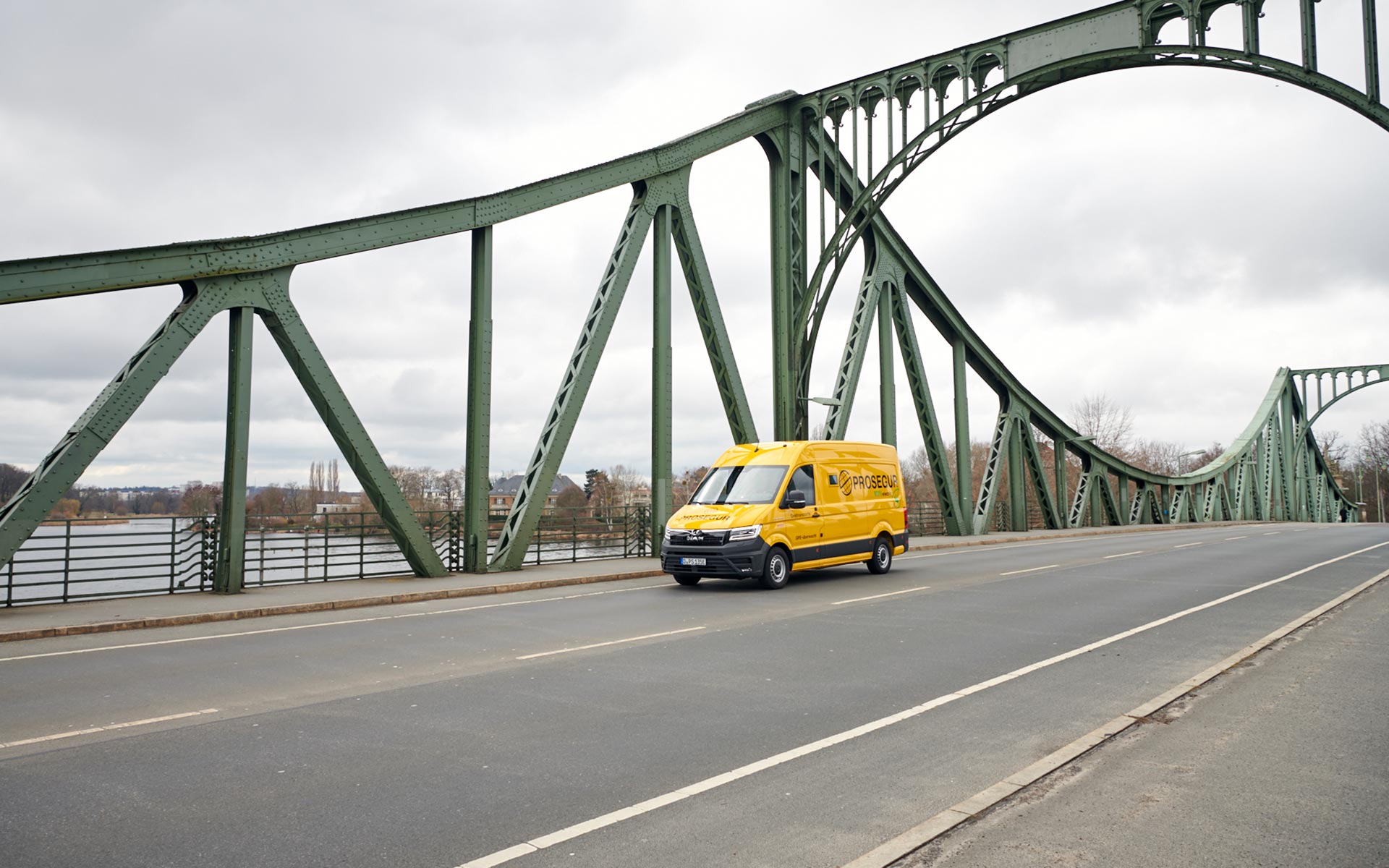
CLEAN AND SECURE
The world’s first armoured electric cash-in-transit van is now deployed at security service provider Prosegur. The use of lightweight armour results in the electrically powered MAN eTGE having sufficient payload and range for urban traffic. A trip around in Potsdam with the eco-friendly security guards.
Security reasons dictate that Prosegur security guards always travel in twos or threes – a well-rehearsed team. Today Uwe Engelmann is driving the yellow cash-in-transit van through Potsdam. His colleague Andreas Hesse is keeping a close eye on their surroundings from the passenger seat. He is mainly watching out for hedges, courtyards and other potential hiding places. Because that’s where “the others” could be lying in wait. This is what Hesse calls criminals who are intent on stealing the cash and valuables being transported in the vehicle, which is doubly protected by an armoured outer skin and an armoured inner shell. The route for every journey, which in each case includes calling at several banks, cash machines or retail outlets, is planned in great detail to minimise the risk of robbery. Security personnel at Prosegur’s Potsdam branch are observing on a monitor how the GPS signal from the MAN eTGE moves through the city and are in radio contact with the two security guards. Both driver and passenger are alert as the electrically powered van glides almost silently through the streets. “This peace and quiet during the journey is brilliant”, says security guard Andreas Hesse. “I can focus so much better without all that noise, and I’m less exhausted at the end of our working day.”
And yet its silent drive train is not the main reason why Prosegur is deploying the world’s first armoured electric cash-in-transit van. The company is seeking to prove to itself and the entire security sector that electric mobility is not merely suitable for general delivery traffic, but also for the particular requirements of transporting cash and valuables – despite the additional weight of the armour, which reduces the vehicle’s payload and the already restricted range of the electric battery.
Lightweight armour
Prosegur was already pleased with the conventional MAN TGE in its fleet, so the MAN TGE 3.140 E battery-powered version was chosen as the test vehicle. The company STOOF fitted it with FB3 level armour, but dispensed with steel to save weight. Instead they installed aramid fabric – a lightweight, high-performance fabric that is also used by the military for armoured vehicles and protective clothing. This enabled the cash-in-transit van to have an inherent weight of just 3,150 kilogrammes, including its armour. “Its battery charge provides a range of around 120 to 130 kilometres. That’s perfectly adequate for our trips around the city”, says Alexander Lange, fleet manager at Prosegur. “Our electric cash-in-transit van travels 70 to 90 kilometres per day. That leaves sufficient range as a safety margin.”
Prosegur has been using the MAN eTGE since September 2020. It is now fully integrated into normal operations. The test phase has been successfully completed. The proof has been provided: eco-friendly transport of valuables without local emissions is feasible. The electric version has proven itself in the best possible way. “As a company with a large fleet of vehicles, we want to make an important contribution to climate protection, so there is no way around electric cash-in-transit vehicles,” announces Jochen Werne. Prosegur’s chief development officer in Germany estimates that “A large part of our tours – especially in urban areas – can be realised with battery-electric vehicles.” For supra-regional shuttle transports, according to the current state of the art, another drive solution with a higher range is still required.
Conversion to electric mobility at Prosegur will only occur in small steps, however, due to the high investment involved. Jochen Werne reckons that on top of the vehicle procurement costs – their fleet includes 900 cash-in-transit vans and 300 service vehicles – there would be substantial cost involved in developing the charging infrastructure. The MAN eTGE has until now been charged overnight at a simple 230-volt socket. The battery is fully recharged after around eight hours. “In future though, we want to install a high-power charging station for each electric vehicle to fully make use of the advantages of electric mobility”, Werne explains. Despite the associated investment levels, Prosegur’s chief development officer also sees a major economic opportunity in electric mobility: “This technology can be used to save money in the long-term, because fuel costs are eliminated.”
Climate protection by example
Prosegur in Potsdam is using its MAN eTGE to set a clearly visible example for climate protection.
The routes taken by our armoured e-van often pass some of the city’s tourist hotspots, like the Sanssouci summer palace. A lot of people notice it there. We often receive questions about the vehicle.
branch manager Ulf Borchert
Security guards Uwe E. and Andreas H., conversely, want to draw as little attention as possible to themselves given their risky job. They park as close to the entrance as possible at each customer’s premises. Uwe E. quickly slips into the protection of the building and is soon back in the vehicle. For the short distance, he carries the valuable cargo in a special transport security device. Once their round is complete, the security guards drive their “armoured e-van” through a security gate and back onto the Prosegur site. Secure and clean.









